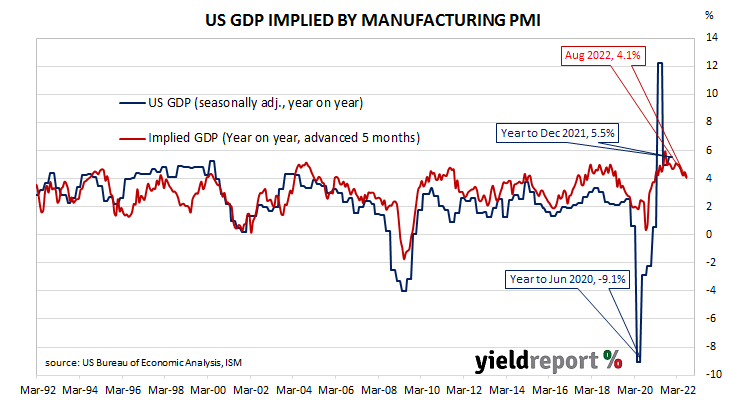Summary: ISM PMI down from 58.6% to 57.1% in March; below consensus expectation; progress on labour shortages made “at all tiers“ of supply chain, “increasing rates of price expansion”, suppliers not waiting to pass on higher prices; latest reading implies 4.1% 12-month US GDP growth rate in August.
The Institute of Supply Management (ISM) manufacturing Purchasing Managers Index (PMI) reached a cyclical peak in September 2017. It then started a downtrend which ended in March 2020 with a contraction in US manufacturing which lasted until June 2020. Subsequent month’s readings implied growth had resumed, with the index becoming stronger through to March 2021. Since then, readings have remained at elevated levels despite recent declines.
According to the ISM’s March survey, its PMI recorded a reading of 57.1%, below the generally expected figure of 59.0% and a lower than February’s 58.6%. The average reading since 1948 is 53.0% and any reading above 50% implies an expansion in the US manufacturing sector relative to the previous month.
“In March, progress was made to solve the labour shortage problems at all tiers of the supply chain, which will result in improved factory throughput and supplier deliveries,” said Timothy Fiore, Chair of the ISM’s Manufacturing Business Survey Committee. He noted “increasing rates of price expansion, due primarily to instability in global energy markets” and further said suppliers were not waiting for their costs to rise before negotiating higher prices with their customers.
The report was released on the same day as the latest non-farm payrolls report and US Treasury yields rose with the exception of ultra-long yields. By the close of business, the 2-year Treasury bond yield had gained 12bps to 2.46%, the 10-year yield had added 4bps to 2.38% while the 30-year yield finished 1bps lower at 2.44%.
In terms of US Fed policy, expectations of a higher federal funds rate over the next 12 months hardened. At the close of business, May contracts implied an effective federal funds rate of 0.725%, 40bps higher than the current spot rate. August contracts implied a rate of 1.61% and March 2023 futures contracts implied 2.755%, 243bps above the spot rate.
Purchasing managers’ indices (PMIs) are economic indicators derived from monthly surveys of executives in private-sector companies. They are diffusion indices, which means a reading of 50% represents no change from the previous period, while a reading under 50% implies respondents reported a deterioration on average. According to the ISM’s latest announcement, a reading “above 48.7%, over a period of time, generally indicates an expansion of the overall economy.”
The ISM’s manufacturing PMI figures appear to lead US GDP by several months despite a considerable error in any given month. The chart below shows US GDP on a “year on year” basis (and not the BEA annualised basis) against US GDP implied by monthly PMI figures.
According to the ISM and its analysis of past relationships between the PMI and US GDP, March’s PMI corresponds to an annualised growth rate of 2.9%, or 0.7% over a quarter. Regression analysis on a year-on-year basis suggests a 12-month GDP growth rate of 4.1% five months after this latest report.
The ISM index is one of two monthly US PMIs, the other being an index published by IHS Markit. IHS Markit also produces a “flash” estimate in the last week of each month which comes out about a week before the ISM index is published. The IHS Markit March flash manufacturing PMI registered 58.5%, 1.2 percentage points higher than February’s final figure.



